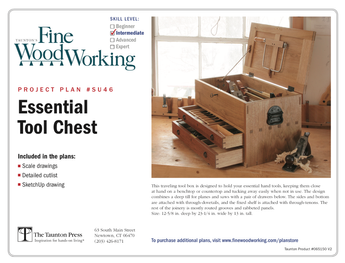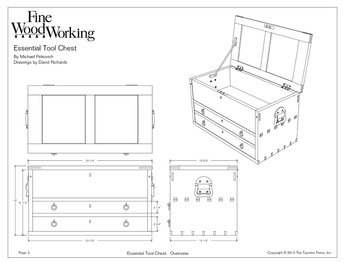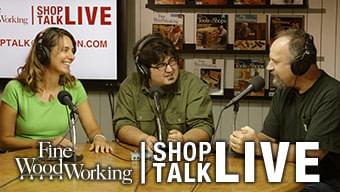Table Saw Blade Marks on Wood
This pic is a piece of a of pine I ripped on a Grizzly Cabinet saw, Ridge Super Rip 24T blade. I don’t think it is dull but it has seen 4 years of hobby woodworker use. I previously paralleled the blade to the fence with a Superbar, which was done 4 years ago also. I have a Microjig push block. That cut looks like I am trembling while I cut. Observations?
*******************************************************************************
I reseated the blade, cleaned arbor. Cut another piece and I still have saw marks. I checked to see if the blade is parallel and included 2 more pics, are those 1000th’s? I don’t know if this amount of variance causes wobble. That blade states you can cut a glue edge and I think it was much better at one time.


















Replies
Have you put the blade back on recently? It looks like maybe there is some crud between the blade and arbor plate to put the blade out of kilter.
Even though a 24T blade is a ripping blade you will get a better finish with a 50T combination blade - IMO.
You shw two pictures of your meter (appears to represent thousandths of an inch). One reading is a bit under .002 and the other a bit over .006, so a difference of over .004 inches. Is this over the width of the blade? If so, certainly enough to cause ghe marks you are seeing. Ditto also about cleaning the arbor plate, though sounds like you've done that. You should realign miter slot (table surface) and fence with blade. Could your blade be warped?
A skinny board will chatter sometimes. They are hard to hold down properly as they go past the blade. I'm assuming those marks are from the back of the blade? Projecting the curve out it looks like the blade is up pretty high for what you are cutting.
Try your test again with a board wide enough to hold both down and against the fence throughout the cut. Take at lease 1/4" off the board, not just a skim cut. Only judge by the part you are holding, not the cutoff.
Also, 4 years is a longass time. I am also a hobbyist and I've never seen a blade last so long between sharpenings.
Ridge should be a good blade but maybe a little dull. I find what I call a dampener and everyone else calls a stiffener to be helpful in controlling some runout. Saw marks happen, I don't ever expect a table saw cut to end up the final finish and allow for that. Gouged cut ? then you have a problem. I would try a different blade, check everything for alignment..check it again. Sometimes it's not the mechanics it's the wood - not as square,not as straight as you think or operator error - going to fast or to slow. I find often when I switch from pushing a board through by hand and then switching over to a push stick there is sometimes a momentary stop and I get a mark at that point.
The regularity of the deep cut says that the blade is defective. Possibly a bent tooth. As another said, try a different blade.
At 3450RPM and a conservative feed rate of 1" per second a defective tooth or bent / warped blade is rotating through the cut almost 60 times per second. If it were either of those things or even a dirty arbor washer the cut would be more like from a wobble style dado blade... wavy and rough but without a regular line. Even a faster feed rate of 2" per second the pattern makes no sense. Am I missing something?
How can a single bad tooth possibly leave that pattern? It seems like it has to be stock vibration at the rear of the cut. When I imagine myself pushing the stick in the photo past a sawblade that is set up higher than just a bit above the stock I pee a little. I think a nice long "topper" style push stick and some featherboards are the answer.
Basic troubleshooting is to try a known good blade.
If you don't have one, then it's certainly time to buy one.
You can try cleaning it, too. I often clean my blades and notice pretty big changes when I do.
Wow, things to try, different blade, thicker wood, wider wood, maybe adjust bed. Thanks all!
Maybe just start by having your blade Sharpened, it does make a difference.
Is it cheaper to buy a new blade or send it off to be sharpened and then not do anything until it returns? I use Freud glue line rip or heavy duty rip blades depending on the project. I think they are around $60. What does sharpening cost?
So, if you need one blade sharpened, you're better off buying a new blade.
The shipping is the issue. At least from what I've seen. So if you've got a local shop that will do a good job, then you're a lucky duck.
Beyond that, rack up your blade collection first. Once you have a bunch of blades that need sharpening, you send them in all at once, and it makes economic sense at that point.
I keep a pristine blade for each machine for troubleshooting purposes.
Yes, if you buy inexpensive saw blades. Mine cost $200 each, dado set is $300. So using until they’re dull and going out and buying a new one would be stupid, which I’m not immune to. :-) It’s $18-20 plus shipping from one service I’ve used, Ridge charges $15-30 depending on how many teeth, with $12 for return shipping for 1st blade, and only $1.00 for additional blades (a bargain), Forrest has a similar plan.
After 4 years of use, it's entirely possible that it needs sharpening. However, blades should be cleaned regularly (I don't do it often enough.) to remove pitch, etc. Just cleaning it can sometimes make a difference if the blade is still sharp, but I don't think that is the cause of sawblade marks.
Unless I'm ripping 8/4 or thicker I rarely use a rip blade (24T), but I do relatively short rips for most of my work. Freud sells some glue line rip blades that have 30 (or 30+) teeth that rip cleanly, but there will likely still be a mark or so.
I almost never glue right off the tablesaw. I add the tiny bit extra to the rough width and make one or two passes on my jointer, taking a tiny bit off each pass. That's the only way I know to get a perfect edge, especially important when gluing up multiple boards for width. I have never been able to get that same perfect edge from the tablesaw, no matter what blade I've used.
I remember having had this conversation with a fellow woodworker 50 years ago ,well more actually, couldn't have been later than 1973 because I remember where it took place, my shop at the time ,and that ended that year. Jointer vs tablesaw for producing glue joints was the topic. He argued that a jointer for that task was redundant because of advancements in blade technology. That's how he did it- no jointer, and there was nothing about the work that he did that would make one believe that he had it wrong. Later I heard Sam Maloof make the same statement and uncannily in almost the exact same words.
I have done joints that way with just a tablesaw cut but often I will use a jointer or plane by hand. I also have a jig I made for a router table that works pretty much like a jointer for narrower boards. I use it specifically for cleaning saw chatter off the edges of straightened boards. It removes about sub 1/64th" in one pass and never causes end snip- unlike my jointer. Its perfectly square because I made it that way.
The trick for using just a table saw to create a glue joint is to have a very good blade and to have a way to produce a very straight cut. I have a set up for that that uses a straight edge that the board is clamped to. One pass through gives you one straight edge- flip the board end for end and you can then use the fence to cut a parallel side, flip it again and recut the first side to the finished width. Do your glue up right away before the wood decides to do what wood can do. Though, I think that's a good idea no matter how you produced your edges for joining.
Good blades are essential for fine work. I have acquired quite a few. I use a local saw sharpening service, they do good work and it costs me about 30 bucks each time. I have found however that cheap blades can be quite good ,-especially when new and can cost less that a sharpening on a better blade. They can do a lot of the everyday work and extend the life of my good blades. The saw service I go to actually sells a blade and I think it's called an Avanti and it's a bargain blade but made by Freud. When they dull I toss them or save them for one last time when I'm doing something really bad...recycled material for example..somehow no matter how well Ive checked it out there is always a nail or a screw hiding in there somewhere!